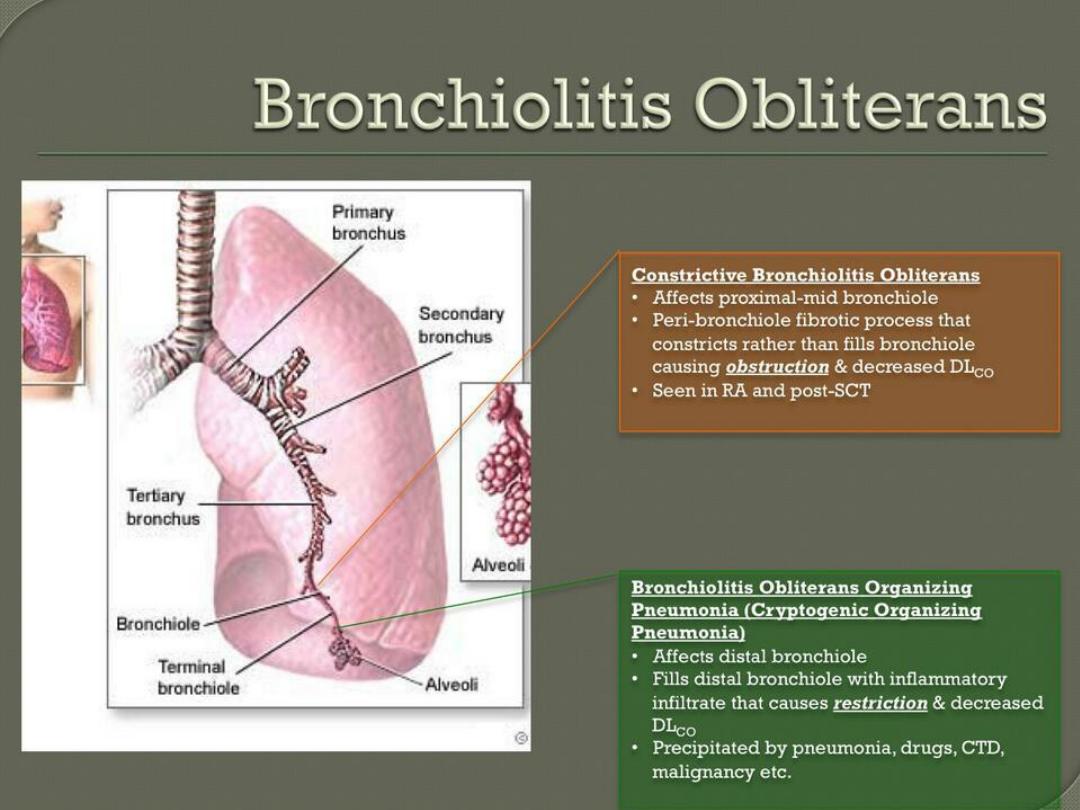
Treatments of croup :---
most a febrile children with spasmodic croup & mild ALTB can
usually be safely effectively managed at home .
Treatments of underlying & often unsuspected G.E.R. may
prevent spasmodic croup .
Treatment at home by :---
1-cool mist from humidifier or sitting with the child in a
bath room( not in the shower) filled with steam generated by
running hot water from the shower . Or
2-steam from a vaporize or
3- cold steam from a nebulizer .
This will result in terminating in acute laryngeal spasm &
respiratory distress within minutes ( same
effect by cold night
air
)
plus
should decreased anxiety which minimized crying
( crying worsen stridor)
Other suggestion for home treatment :----
1-
treat fever by anti pyretic
2-
coughing can be treated by warm
clear fluid to loosen mucus in the oropharynx
3-
avoid smoking in
the home as worse child cough .
4-
keep the child head
elevation
.
G.O.R ( gastro esophageal reflux )

Also can use IPECAC to induce vomiting resulting decreasing spasm, although
vomiting appear to break spasm .
In hypoxic infant , given O2 of less than 100% saturated with H2O vapor
resulting in mucosal cooling leading vaso constriction & decrease edema
• Treatments of patients at hospital :--
•
indication of admission
:--
•
1-
highly or suspected epiqlotitis
2-
progressive strider
• 3-
sever strider at rest
4-
sign of resp. distress like
• hypoxia , irritable , cynosis , sever pallor , depressed
• sensorium .
• For patients who admitted
:---
•
1-
chart observation ( PR ,RR ):--.increasing resp. rate is first sign of hypoxia
•
• 2
-p
arenteral fluid :-
given to replace insensible H2O loss or because of inability to
take oral feeding & decreased risk of aspiration pneumonia
.
•
3-
sedation is Contra indication ( because of restless is used as clinical indices of
• severity of obstruction & need for tracheostomy or endotracheal intubation ) .
•
4-
children should be kept calm as possible to reduce resp. effort
•
5
-O2 to alleviate hypoxia ( humidified O2 )
•
6-
brocho-dilator & expectorant are not helpful & A.B. is not indicated
•
7
-Racemic epinphrine ( o.25 -0.75 ml of 2.25% in 3 ml normal saline can be used
• every 20 minutes causing transient relief of symptoms through vasoconstriction
of pre-capillary arteriol leading fluid resorption from interstitial space and decrease
edema
.

Or
used L-epinpherine ( 5 ml of 1:1000 solution ) is equally effective as Racemic epinpherine
.
Nebulized epinpherine should still be used cautiously in patient with
•
Tachycardia or heart condition like TOF, ventricular outlet obstruction
.
•
8-
cortico steriod to reduce inflamatory edema , prevent destructed celiated epithilial and need
for salvage nebulized epinephrine ( 0ral dexamethazone 0.6 mglKg as
•
Single dose & may be 0.15mglkg may be just effective .
•
I.M decadron & nebulized budesonide have an equally effective ( inhaled budesonide has been
shown to be equivalent to oral dexamethasone ) .
•
9- fewer than 2%of hospitalized children required intubation .
•
10- tracheostomy in sever cases with progressive strider & cynosis
.
•
11- heliox :-is gas that contains a mixture of helium and oxygen ( with not less than 20% O2 ),
delivered through nasal canula , face mask , or hood , it has low viscosity and low specific gravity
which allows for greater air flow through respiratory tract , it has facilitated movement of
O2through air way and decreased mechanical work of respiratory muscle .
•
it used to improved symptoms of severe croup that not respond to nebulized racemic
epinephrine .
•
Indication of laryngoscope in croup :--
•
1-
very young of less than 4 month of age .
•
2-
if symptoms continue of more than one wk
•
3-
patients with 2 or more episode of croup and that had history of intubation and age less
than 3 years
or
had sever prolong disease required inpatient management .
•
laryngoscopy is to exclude sub-glotic stenosis or hemangioma.
•
Pt can be
safely discharge
after 2-3hr period of observation , if:-
•
1- normal air entery,2- normal conscience,3- no strider at rest 4-,received steriod,5- normal pulse
oximetry .
•
N.T ; very young pts of less than 4 month of age or symptoms continue more than one week , the
pt should undergo laryngoscopy to exclude subglotic stenosis or hemangioma -
-3
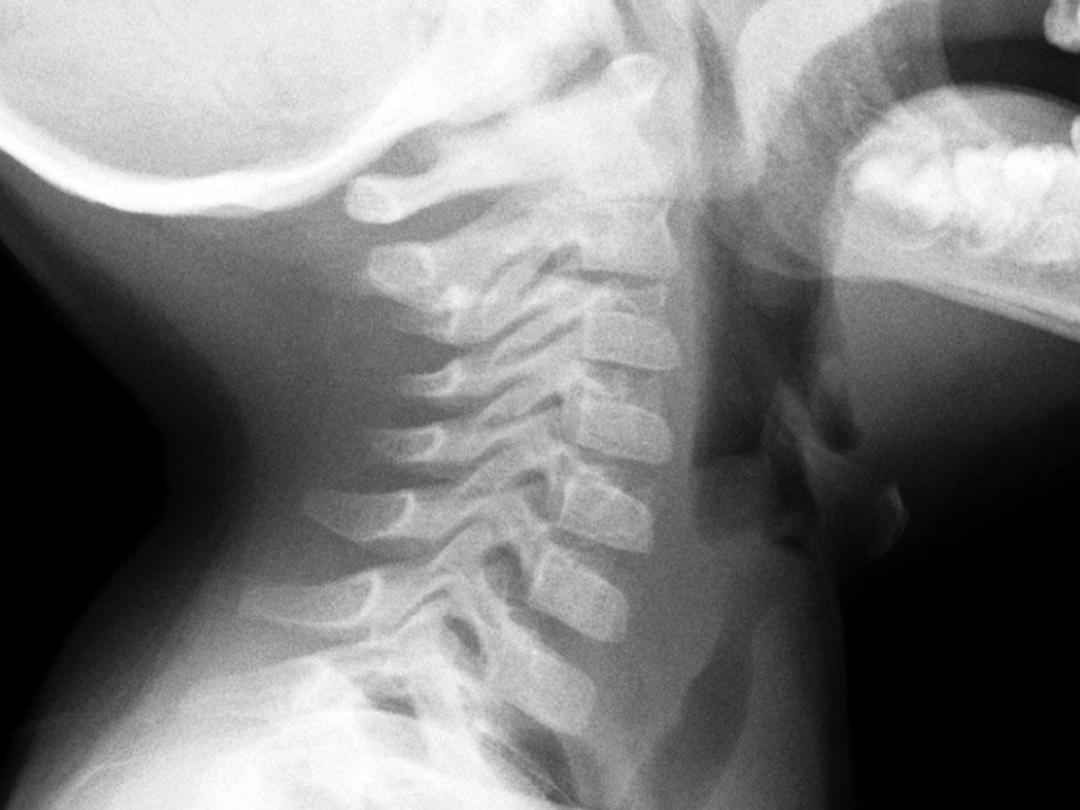
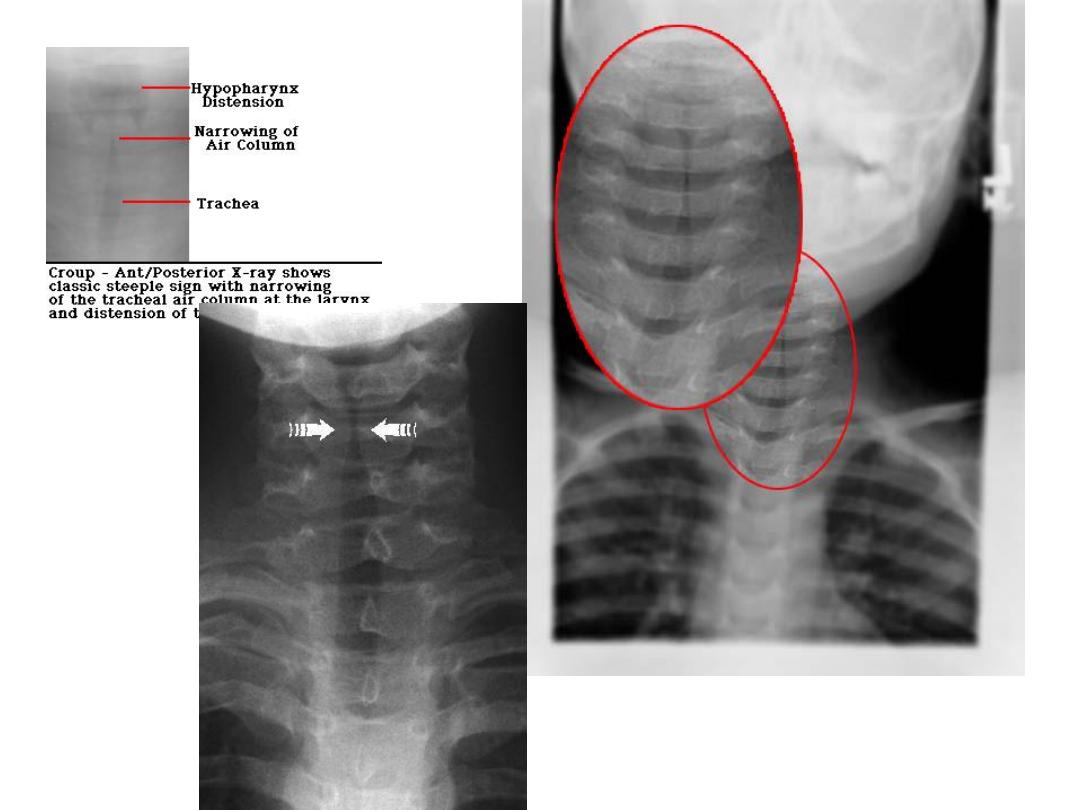

Bacterial tracheitis ;---
is acute bacterial infection of trachea which able to obstruct air way.
Age of incidence of less than 3 years but in more recent cases , the
recently , the mean age between 5 & 7 years
it is more prevalent than acute epiglottitis in children who
have received H. Influenza
type B vaccine
• causes by staph. aureus (most common ) but PIV type 1 & H
influenza ,strepto coccus pyogenes , streptococcus pneumonia ,
moraxalla catarrhalis & anarobic organism also been implicated .
• Usually follow viral resp. infection especially croup .
• ClF :---
•
1-
history of croup, followed by high fever , toxic associated
• respiratory distress or may occur few days after improvement .
•
2-
patients lie flat , not drool , no dysphagia .
•
3-
not respond to general treatment of croup .
• intubation & tracheostomy is usually required ( but in more recent
• series , only 50-60 % of patients required intubation )
• --4--

Pathology :--
1-
mucosal swelling at level of cricoid cartilage
.
2-
thick copious , purulent secretion .
• Diagnosis :--
•
1-
ClF
2-
WBC leucocytosis with band form
•
3-
X-ray is not needed , &may show classical feature pseudo
• membrane detachment in the larynx .
•
4-
laryngoscopy shows purulant material bellow cord .
• Treatment :--
• 1- maintained air way 2- avoid agitation of the child
•
3- supporting
:-
O2 therapy , I.V fluid , intubation in sever cases
• #
4- specific therapy
by A .B ( anti staph )
• CX :---
•
1-
resp. obstruction leading to resp. arrest
•
2-
infection go down to parenchymal or bronchiol leading to pneu.
•
3-
toxic shock syndrome
• Now#
emperical therapy :-vancomycin + naficilin or cloxacillin or clidamycin
( clindamycin in a dose 40 mg /kg /day in 3 doses ) .
• or cefotaxime or ceftriaxone plus oxacillin or naficilin
• & artificial air way should be strongly considered .
• Prognosis :-
become a febrile patient within 2-3 days but may be prolonged
• Hospitalization may be necessary ( mean duration is 12 days )
• ---5--

Lower air way obstruction ;-
DD :-- of wheezing :---
1
- infection :- bronchiolitis , pneumonia .
2-
asthma
•
3
-anotomical abnormalities like :- A– central air way like
• malasia of larynx , trachea, bronchi .
• B-extrinsic air way anomalies by compression like
vascular ring , mediastinal LAB(lymph adeno pathy) , F.B in
esophagus .
• C- intrinsic air way anomalies like hemangioma , cyst ,
• sequestration , F.B, CHD( LF to Rt shunt ) .
•
4-
cystic fibrosis , bronchioactasis .
• 5-
aspiration pneumonia , G.E.R
• 6-
H.F
7-
interstitial lung disease like bronchiolitis
obliterance 8- anaphylaxis .
•
•
--6-
-
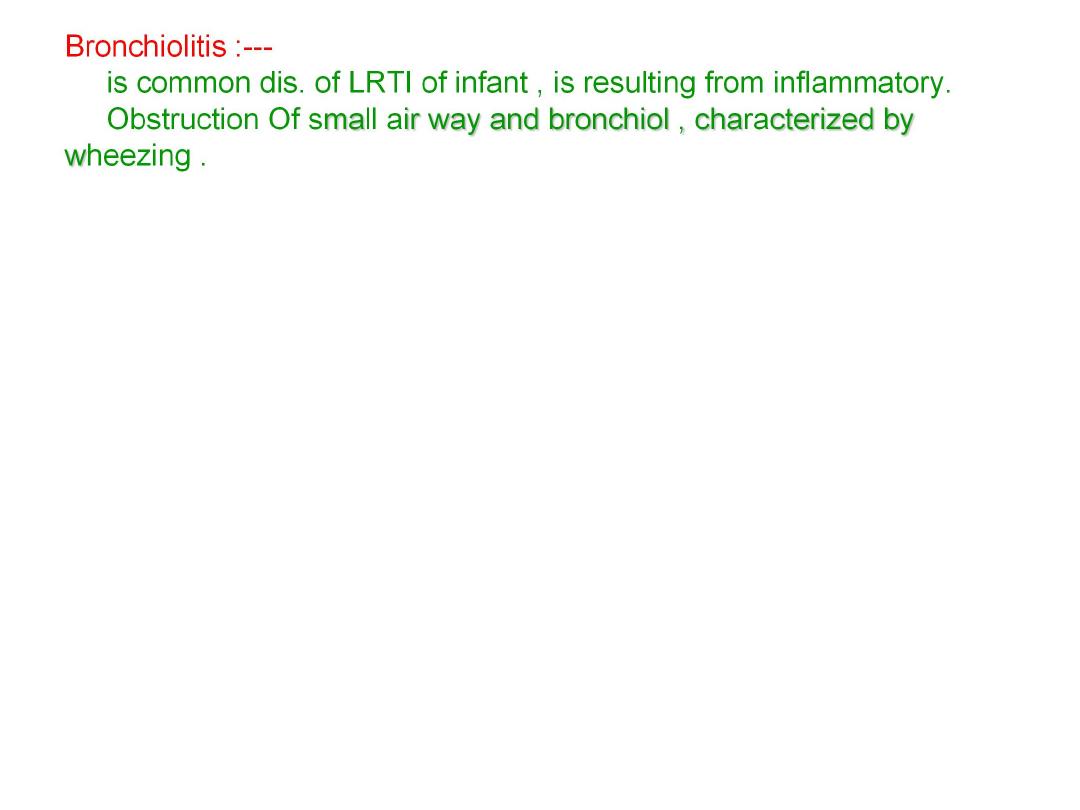
• It occurs in first year of life with peak incidence of 6 month , Its incidence is highest in
the winter & early spring .
• illness occurs sporadically & epidemically
• infant who are breast fed with colostrum rich in immune globulin A appear to be
relatively protected from bronchiolitis .
• Etiology :--
is viral in origin in more than 50% by RSV ( of more than 75% of younger than 2
years of age who are hospitalized patients ) , also can caused by PIV type 3 in 10-
30% of all cases & some of adeno virus , mycoplasma in 5-15 % particularly among
older children .
• is more common in male infant ( 3-6 month) who not breast fed infant , lived in
crowded condition .
• also other member of family is ill .
• Pathophysiology :---
• Invasion of bronchiol resulting in mucosal edema and accumulation of mucous and
debris lead to air way resistance in both inspiration and expiration but because of
radius of air way during expiration is smaller, resulting in ball valve like mechanism
which allow to enter air during inspiration and prevent to exist during expiration
causing early air trapping causing over inflation of chest and atelectasis may occur if
obstruction is completed leading to absorbed trapped air causing impairment of gas
exchange i.e VPM lead to hypoxia in early onset of diseases , where hypercapnia
not usually occur except in severely affected infant .
• Higher respiratory rate lead to decreased arterial O2 tension ( where hypercapnia not
occur unless respiratory rate exceed 60 breath /min. and then increased in proportion
to tachypnea .
•
•
---7---
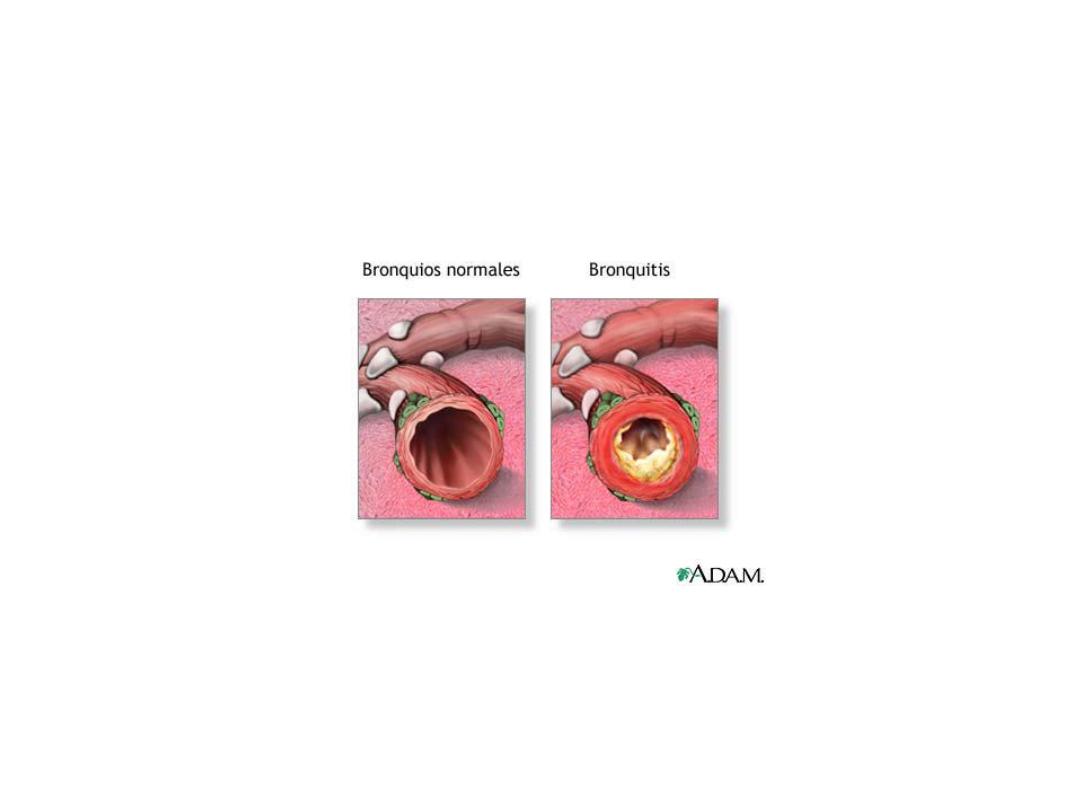
Inflamed bronchiol
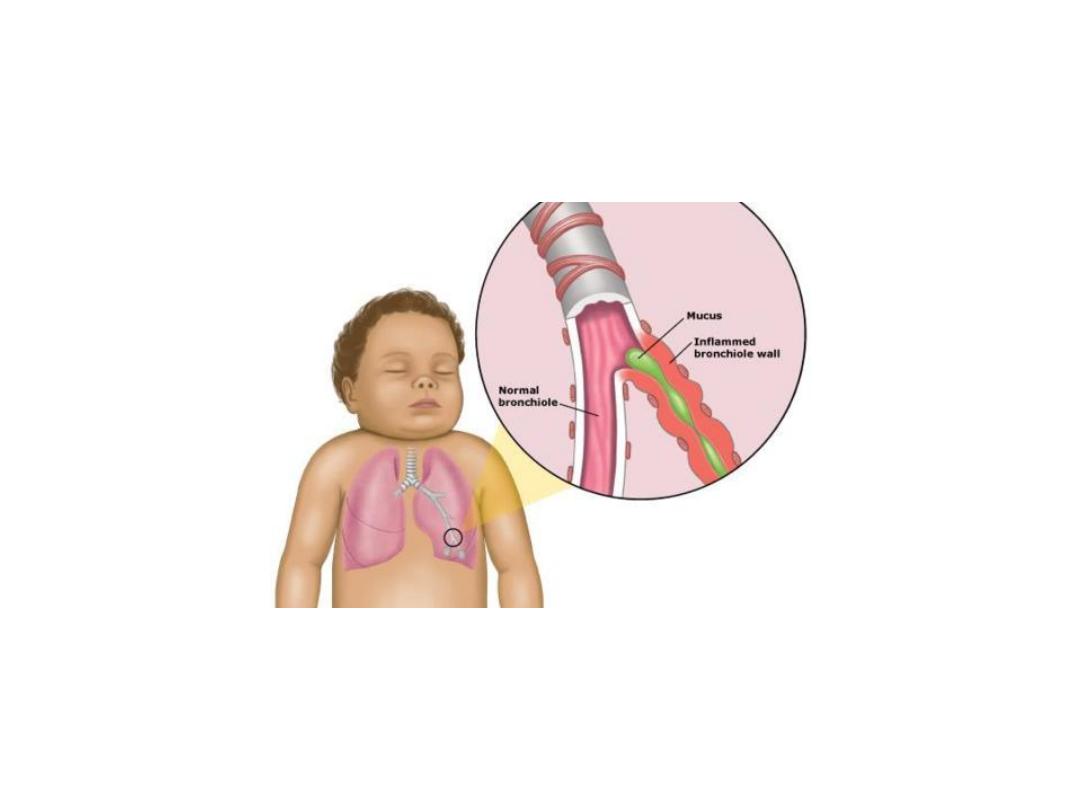
mechanism
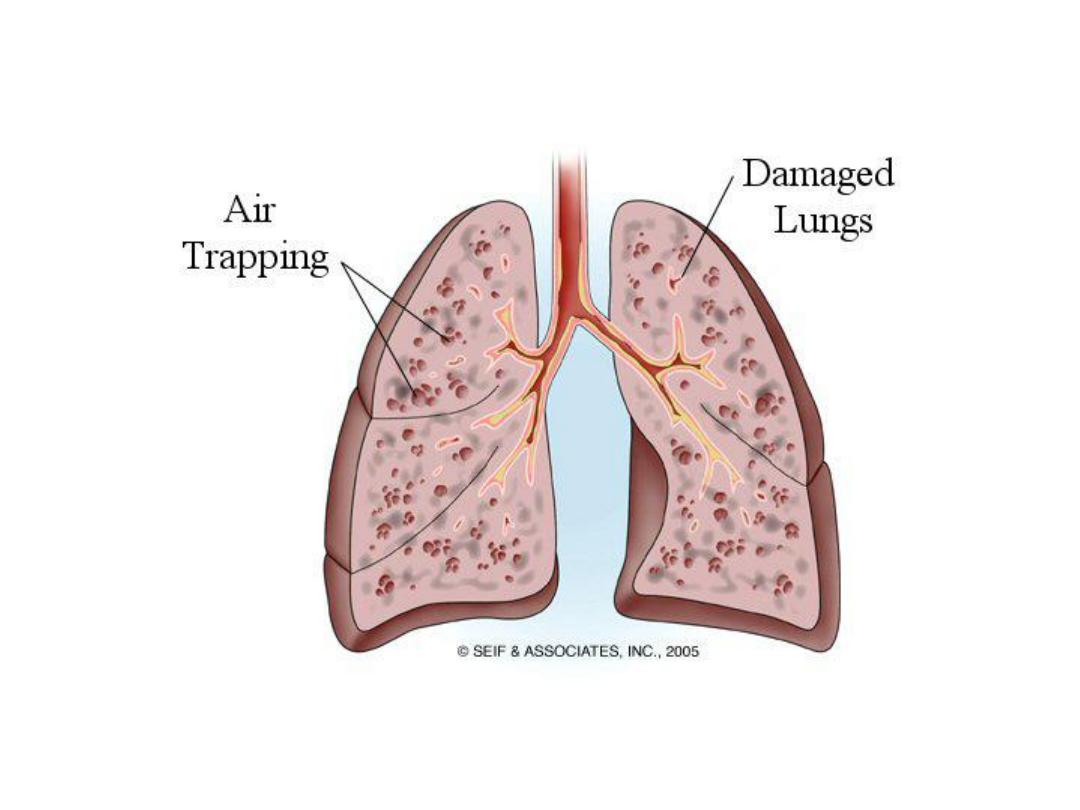
mechanism

ClF :--
1-
usually other member of family were ill by viral infection .
2-
usually proceeded by URTI of few days before onset of resp. distress
which include dyspnea , tachypnea , wheezing , intermittent cynosis
•
3-
low grade fever 38.5—39c & other systemic manifestations like
vomiting & diarrhea are usually
absent.
• Apnea
more prominent than
wheezing
in early course of dis. In
• very young infant of less than 2 month of age or former
premature
infant , it was found that apnea at admission increased risk of recurrent
apnea .
• On Examination :- --
• 1- resp. distress which variable from mild to sever .
• 2- in sever distress with sever hypoxia lead to convulsion &
• dehydration due to insensible water loss .
• Diagnosis :----
• 1- ClF
• 2- X-ray finding ( hyper inflation of chest , scattered area
• of consolidation in 30% caused by atelectasis which
secondary to obstruction or inflammation of alveoli .
• 3- WBC & diffrential count are usually normal
• 4- pulse oximetry :- transcutaneous O2 saturation is reduced in
moderate and severe bronchiolitis however is poor predictor of respiratory
distress ( it correlate best with tachypnea but correlate poorly with retraction
and wheezing ) .
• --8--
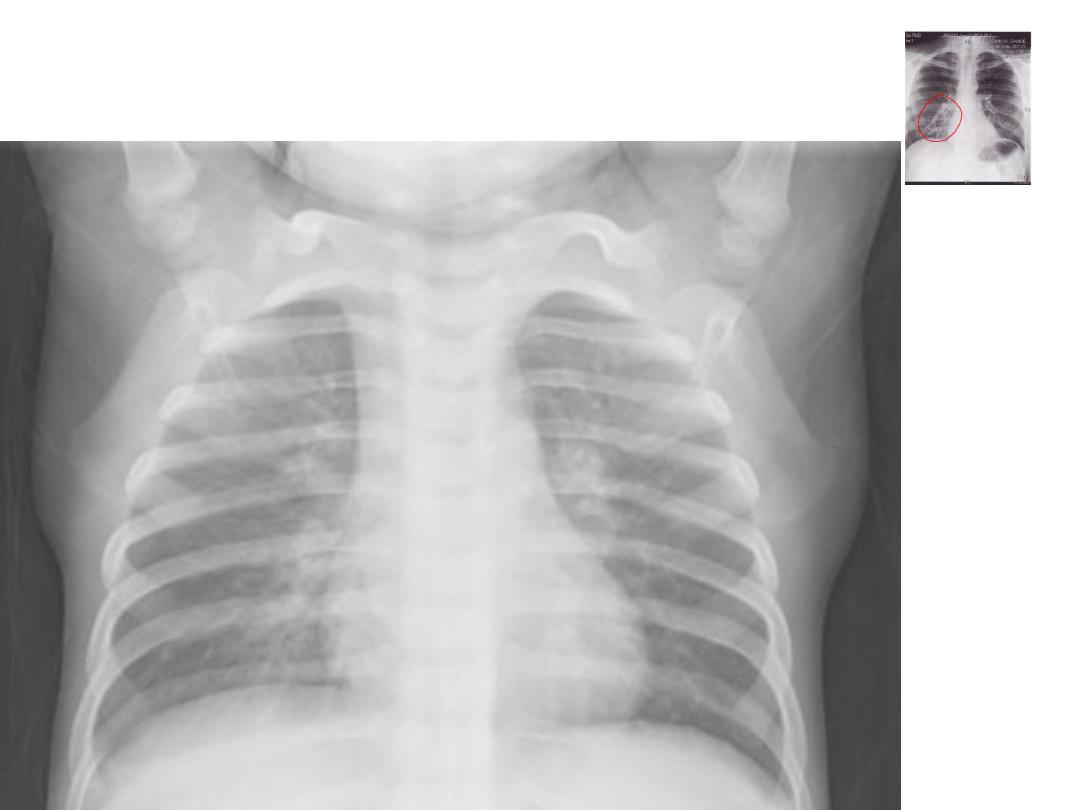

DD :--
1
-
asthma
2-
bronchopneumonia
3-
F.B aspira.
4-
cong. H.F
5-
poisoning
6-
pertusis
7-
cystic fibrosis
• Note :--
50% of sever bronchiolitis may going to asthma
• Course :--
most critical period is 2-3 days after onset of cough &
• dyspnea. & then improvement occurs rapidly & recovery
• is completely within several days ( 10-14 days )
• Death rate :--
is less than 1% ( higher figures associated with higher
• risk groups ) , caused by :---
•
1-
prolong apneic spell
•
2-
sever uncompansated resp. acidosis
•
3-
profound dehydration
• Infant are more liable to morbidity & mortality if associated :---
• 1-CHD 2- BPD 3-Cystic fibrosis 4- immune def. dis.5-in
first 3 month of age if developed .
• H.F is rare CX except if underlying heart dis.
•
---9---

Infant with bronchiolitis who developed asthma , are more likely to
have
:--
1-
family history of asthma & allergy
2-
prolong acute episode of bronchiolitis
3-
exposure to cigarette smoking
• Treatment of bronchiolitis
:--
•
depend on severity of illness
:--
•
most children have mild illness & can be managed at home with
• supporting measures .
•
2-3% of patients needs hospital admission among infant younger 12 months of
age :----indication
of
admission
:----
1-
younger patients of less than 3 months .
•
2-
moderate to marked resp. distress ( marked respiratory
• rate of more than 70-80 breath / minutes)
•
3-
hypoxemia ( po2 of less than 50-60 mmHg ) or
• o2 saturation of less than 92% on room air
• 4-
episode of apnea
•
5-
inability to tolerate oral feeding
•
6-
lack of appropriate care at home
• (
children with CHD, BPD , NMD, immune def. ---- increasing risk of sever potentially
sever dis.)

Supporting measures :--
1-
adequate fluid to maintain normal hydration
2-
antipyretic for febrile patients
•
3-
humidified O2 in sufficient concentration to maintain pao2
• 70-90 mmHg & O2 saturation of more than 92%
•
4-
broncho-dilator like B-agonist produce short term
• improvement in clinical feature .
•
nebulized epinpherine may more effective than B-agonist
.
• nebulized hypertonic 3% saline may improve the symptoms when length of
stay expected to exceed 3 days .
cortico-steriod are often negative
5- frequent suction of nose & oral secretion is essential part and often provide relief of
distress or cynosis (
is essential part of treatment of bronchiolitis )
• Specific therapy :--
•
1-
ribavirine is antiviral agent administered by aerosol has
• been used for infant with CHD or chronic lung dis.
•
2-
no support for RSV immune globuline administered
• during acute episode of RSV .
• prevention ;-1-hyperimmune globulin to RSV,
• 2-palivizumam :IM monoclonal Abs during and before season .
---11--

Bronchiolitis obliterane :--
caused by
adeno virus
,
measles
,
pertusis
,
in which
,there is
damage of bronchiol & smaller air with attempt repaired by granulation
tissue that obstruct the air way , eventually obliterate of lumen with nodular
• masses of granulation & fibrosis .
• ClF :--
gradual progressive resp. distress
•
X-ray :-
ranged from normal to a pattern suggest of milliary T.B
• Bronchography
---
:-obstruct of bronchus
• No specific therapy
• Congenital lobar emphysema :---
• is overinflation of one lobe ( most often left upper lobe ), which
• produced resp. distress because of surrounding lung tissue
become compressed leading to shifting mediastinum
• Treatment
by lobectomy may be required if resp. distress is sever or
• progressive . ---12---
•
